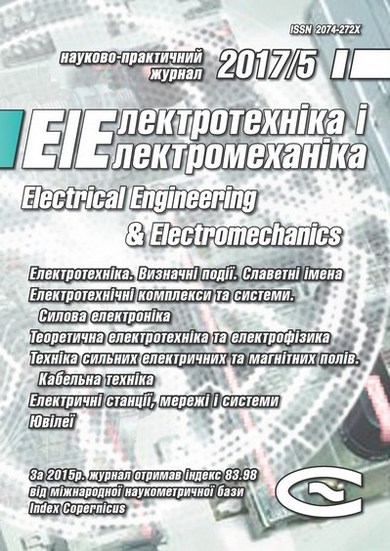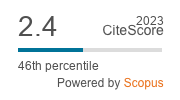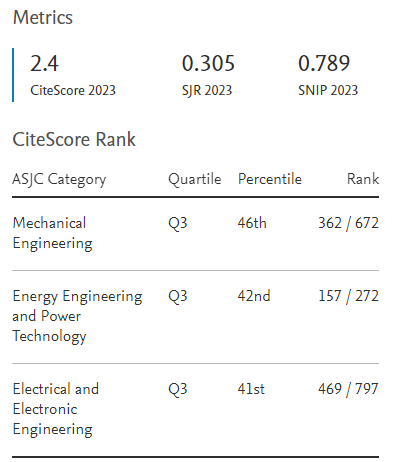INVESTIGATION OF THERMAL PROCESSES IN A LINEAR PULSE-INDUCTION ELECTROMECHANICAL CONVERTER OF CYCLIC ACTION
DOI:
https://doi.org/10.20998/2074-272X.2017.5.02Keywords:
linear pulse-induction electromechanical converter, cyclic action, thermal state, mathematical model, electromechanical and energy processes, intensive cooling, experimental studies, constructive schemeAbstract
Purpose. Investigation of the influence of the intensity of cooling of active elements and the period of succession of power pulses on the thermal processes of linear pulse-induction electromechanical converter (LPIEC) operating in a cyclic mode. Methodology. The electromechanical and energy processes of LPIEC, which arise during the direct course of the working cycle, are investigated. It is shown that by the end of the operating cycle, a significant part of the energy is stored in the capacitive energy storage device, and is also converted into thermal energy of the armature and inductor. With a significant number of operating cycles, an unacceptably high temperature rise of LPIEC active elements occurs. To solve this problem, intensive cooling of the winding of the inductor, the movable armature or both of them, as well as an increase in the pulse repetition period are used. It has been experimentally established that when the LPIEC is operating in a cyclic mode, the inductor winding with a steel frame blown with air is heated more slowly than the winding with an insulating frame. The experimental dependences with an accuracy of 6 % coincide with the calculated results. A constructive scheme of the LPIEC of cyclic action with intensive cooling of the stationary winding of the inductor has been developed. Results. A mathematical model of the LPIEC of cyclic action is developed, taking into account a complex of interrelated electromechanical and thermal processes. The solutions of its equations are represented in a recurrent form. The electromechanical and energy processes of LPIEC, which arise during the direct course of the working cycle, are investigated. It is shown that for a considerable number of operating cycles, unacceptably high temperature excesses of active elements of the LPIEC are observed. It is shown that intensive cooling of the winding of the inductor, the movable armature or both of them, and also the increase in the pulse repetition period ensure the temperature stabilization of the LPIEC. Measurements of the temperature on the surface of the winding of the inductor LPIEC during cyclic operation are carried out. A constructive scheme of the LPIEC of cyclic action with intensive cooling of the stationary winding of the inductor has been developed. Originality. A mathematical model of the LPIEC of cyclic action is developed, taking into account a complex of interrelated electromechanical and thermal processes. The solutions of its equations are represented in a recurrent form. It is shown that by the end of the working cycle a significant part of the energy is converted into thermal energy of the armature and inductor. It is determined that for a significant number of operating cycles, unacceptably high temperature excesses of active elements of the LPIEC are observed. It is shown that intense cooling of active elements, as well as an increase in the pulse repetition period, ensure the temperature stabilization of the LPIEC. A design scheme of the LPIEC with intensive cooling of the stationary winding of the inductor has been developed. Practical value. It is shown that by thermal cooling of at least one of the active elements and by increasing the pulse repetition period, the temperature stabilization of the LPIEC is ensured. A constructive scheme of the LPIEC of cyclic action with intensive cooling of the stationary winding of the inductor has been developed.References
1. Bissal A. Licentiate thesis on the design of ultra-fast electro-mechanical. Stockholm, Sweden. 2013. 120 p.
2. Chemerys V.T., Bolyukh V.F. Prospectives of new coilgun design development. Artillery and small arms, 2008, no.3, pp. 44-52.
3. Bolyukh V.F., Vinnichenko A.I. Concept of an induction-dynamic catapult for a ballistic laser gravimeter. Measurement Techniques, 2014, vol.56, iss.10, pp. 1098-1104. doi: 10.1007/s11018-014-0337-z.
4. Naumov I.V, Bolyukh V.F., Breslavskiy D.V. Deformation and fracture of the plates during loading cylindrical drummer. Mechanics and engineer, 2010, no.1, pp. 207-216. (Rus).
5. Bolyukh V.F., Shchukin I.S. Lineinye induktsionno-dinamicheskie preobrazovateli [Linear induction-dynamic converters]. Saarbrucken, Germany, LAP Lambert Academic Publ., 2014. 496 p. (Rus).
6. Bolyukh V.F., Shchukin I.S. The thermal state of an electromechanical induction converter with impact action in the cyclic operation mode. Russian electrical engineering, 2012, vol.83, no.10, pp. 571-576. doi: 10.3103/s1068371212100045.
7. Bolyukh V.F., Luchuk V.F., Rassokha M.A., Shchukin I.S. High-efficiency impact electromechanical converter. Russian electrical engineering, 2011, vol.82, no.2, pp. 104-110. doi: 10.3103/s1068371211020027.
8. Bolyukh V.F., Oleksenko S.V. The influence of the parameters of a ferromagnetic shield on the efficiency of a linear induction-dynamic converter. Russian Electrical Engineering, 2015, vol.86, no.7, pp. 425-431. doi: 10.3103/s1068371215070044.
9. D.-K. Lim, D.-K. Woo, I.-W. Kim, D.-K. Shin, J.-S. Ro, T.-K. Chung, H.-K. Jung. Characteristic Analysis and Design of a Thomson Coil Actuator Using an Analytic Method and a Numerical Method. IEEE Transactions on Magnetics, 2013, vol.49, no.12, pp. 5749-5755. doi: 10.1109/tmag.2013.2272561.
10. Podoltsev A.D., Kucheriava I.N. Mul'tifizicheskoe modelirovanie v elektrotekhnike [Multiphysical modeling in electrical engineering]. Kyiv: Institute of Electrodynamics of NAS of Ukraine, 2015. 305 p. (Rus).
11. L. Shoubao, R. Jiangjun, P. Ying, Z. Yujiao, Z. Yadong. Improvement of Current Filament Method and Its Application in Performance Analysis of Induction Coil Gun. IEEE Transactions on Plasma Science, 2011, vol.39, no.1, pp. 382-389. doi: 10.1109/tps.2010.2047276.
12. Bolyukh V.F., Lysenko L.I., Bolyukh E.G. Parameters of high-efficiency pulsed inductive electromechanical converters. Russian Electrical Engineering, 2004, vol.75, no.12, pp. 1-11.
13. Bolyukh V.F., Luchuk V.F., Shchukin I.S. Induktsionno-dinamicheskii elektrodvigatel' tsiklicheskogo deistviia [Induction-dynamic electric motor of cyclic action]. Patent Russian Federation, no. 2467455, 2012. (Rus).
Downloads
Published
How to Cite
Issue
Section
License
Copyright (c) 2017 V. F. Bolyukh, I. S. Schukin

This work is licensed under a Creative Commons Attribution-NonCommercial 4.0 International License.
Authors who publish with this journal agree to the following terms:
1. Authors retain copyright and grant the journal right of first publication with the work simultaneously licensed under a Creative Commons Attribution License that allows others to share the work with an acknowledgement of the work's authorship and initial publication in this journal.
2. Authors are able to enter into separate, additional contractual arrangements for the non-exclusive distribution of the journal's published version of the work (e.g., post it to an institutional repository or publish it in a book), with an acknowledgement of its initial publication in this journal.
3. Authors are permitted and encouraged to post their work online (e.g., in institutional repositories or on their website) prior to and during the submission process, as it can lead to productive exchanges, as well as earlier and greater citation of published work.





